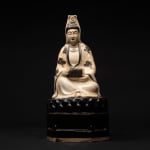Ming/Qing Pottery Seated Guanyin, 16th Century CE - 19th Century CE
Pottery
38.1 x 19.1 cm
15 x 7 1/2 in
15 x 7 1/2 in
HK.2011
Further images
This is a pottery figure of Guanyin in Taoist outlook. Seated in semi-relaxed posture on a risen lotus pedestal, her bare right foot reaches out from the robe. Her robe...
This is a pottery figure of Guanyin in Taoist outlook. Seated in semi-relaxed posture on a risen lotus pedestal, her bare right foot reaches out from the robe. Her robe is decorated with a pattern of auspicious clouds, symbolising the deity’s transcendent nature and association with heaven. Holding a stack of books on her lap, she is known as the “Classics-Wielding Guanyin” in folk religion, the protector of scholars and students. Painted and glazed in thin pottery, the use of monotone paint gives it a rustic feel.
Avalokitesvara, or Guanyin in Chinese, has become extremely popular in Chinese folk religion. The invention of his new forms, such as the Water Moon Form, has stimulated people’s boundless imagination of the deity. Derived from the Water Moon Form, the Taoist Guanyin becomes a female deity who dresses in an elegant white robe, further enhancing her purity and transcendental compassion.
This sculpture bears the characteristics of both Taoist and Buddhist Guanyin. It testifies to the common Buddhist depiction by including Amitabha on the headdress, while maintaining its primary Taoist outlook. In other words, it embodies the negotiation between Taoism and Buddhism manifested through their shared deity Guanyin.
Avalokitesvara, or Guanyin in Chinese, has become extremely popular in Chinese folk religion. The invention of his new forms, such as the Water Moon Form, has stimulated people’s boundless imagination of the deity. Derived from the Water Moon Form, the Taoist Guanyin becomes a female deity who dresses in an elegant white robe, further enhancing her purity and transcendental compassion.
This sculpture bears the characteristics of both Taoist and Buddhist Guanyin. It testifies to the common Buddhist depiction by including Amitabha on the headdress, while maintaining its primary Taoist outlook. In other words, it embodies the negotiation between Taoism and Buddhism manifested through their shared deity Guanyin.











